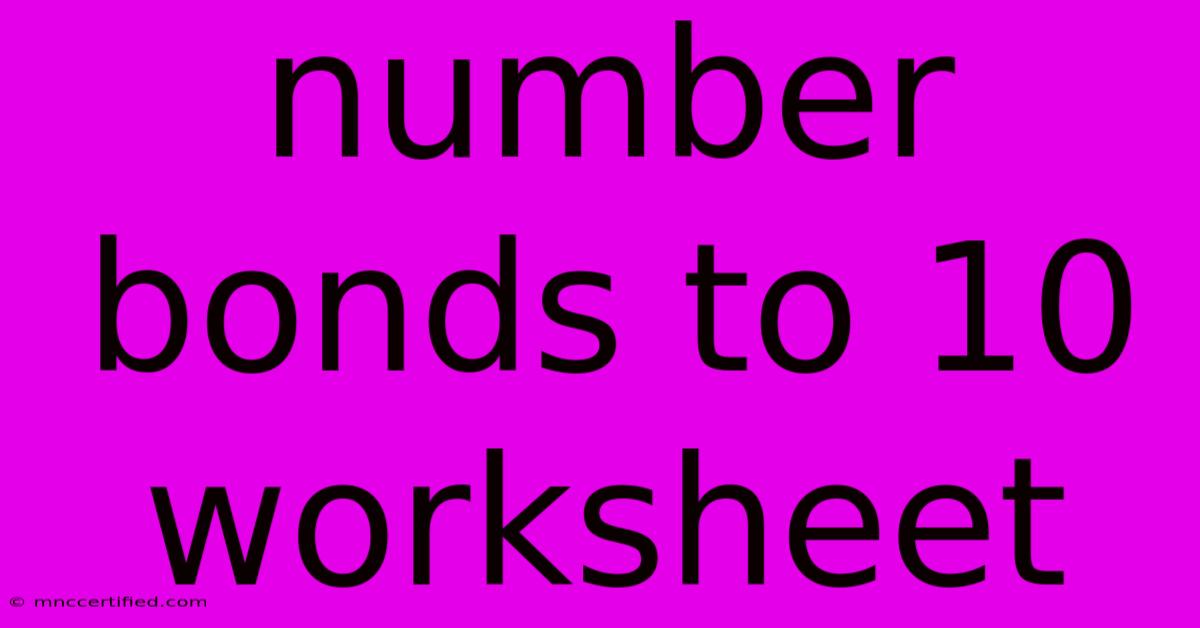Number Bonds To 10 Worksheet

Table of Contents
Number Bonds to 10 Worksheets: A Complete Guide for Parents and Teachers
Number bonds are a fundamental concept in early childhood mathematics, forming the building blocks for addition and subtraction. Mastering number bonds to 10 is crucial for developing a strong number sense and lays the groundwork for more advanced mathematical skills. This comprehensive guide explores the importance of number bonds to 10 worksheets, providing valuable insights for parents and educators on how to effectively utilize them.
What are Number Bonds?
Number bonds illustrate the relationship between numbers that add up to a specific total. For number bonds to 10, we focus on all the pairs of numbers that combine to make 10. For example, 1 + 9, 2 + 8, 3 + 7, 4 + 6, and 5 + 5 are all number bonds to 10. Visual representations, often using circles or diagrams, help children understand this concept intuitively.
Why are Number Bonds to 10 Worksheets Important?
Number bonds to 10 worksheets offer a structured and engaging way to reinforce this crucial mathematical concept. They provide numerous benefits, including:
-
Building Number Sense: Repeated practice with number bonds strengthens children's understanding of number relationships and improves their ability to quickly recall addition and subtraction facts.
-
Developing Mental Math Skills: Regular use of these worksheets encourages mental calculation, reducing reliance on counting fingers or other physical aids.
-
Boosting Problem-Solving Abilities: Number bonds often involve finding missing numbers, enhancing problem-solving skills and fostering critical thinking.
-
Enhancing Memory Retention: Visual and repetitive practice aids memory retention of number facts, making calculations faster and more efficient.
-
Preparing for Future Math Concepts: A solid grasp of number bonds to 10 is essential for learning more complex mathematical operations, such as addition and subtraction with larger numbers and multiplication.
Types of Number Bonds to 10 Worksheets
Various types of worksheets cater to different learning styles and levels:
-
Simple Fill-in-the-Blank: These worksheets present a number bond diagram with one or two numbers missing, requiring children to fill in the blanks.
-
Matching Activities: Children match number pairs that add up to 10, enhancing visual recognition of number bonds.
-
Number Line Activities: These worksheets incorporate number lines to visually represent the addition and subtraction involved in number bonds.
-
Word Problems: These introduce real-world scenarios requiring children to apply their knowledge of number bonds to solve problems.
-
Coloring Activities: Combining fun with learning, these worksheets involve coloring pictures based on number bond solutions.
How to Use Number Bonds to 10 Worksheets Effectively
To maximize the benefits of number bonds to 10 worksheets:
-
Start Simple: Begin with simpler worksheets and gradually increase the complexity.
-
Regular Practice: Consistent, short practice sessions are more effective than infrequent, long ones.
-
Positive Reinforcement: Praise and encouragement foster a positive learning environment.
-
Variety is Key: Utilize different types of worksheets to keep children engaged and challenge their understanding.
-
Relate to Real-World Scenarios: Connect number bonds to everyday situations to make learning more relevant and memorable.
-
Assess Progress: Regularly assess your child's understanding to identify areas needing further attention.
Finding Number Bonds to 10 Worksheets
Numerous online resources and educational websites offer free printable number bonds to 10 worksheets. Search terms like "number bonds to 10 worksheets pdf," "free printable number bonds worksheets," or "number bonds to 10 activities" will yield numerous results. You can also find suitable resources through educational app stores and online learning platforms.
Conclusion
Number bonds to 10 worksheets are invaluable tools for reinforcing early mathematical skills. By understanding their importance and utilizing them effectively, parents and teachers can significantly contribute to children's mathematical development and build a strong foundation for future learning. Remember to choose age-appropriate worksheets and create a supportive learning environment to help children master this essential skill.

Thank you for visiting our website wich cover about Number Bonds To 10 Worksheet. We hope the information provided has been useful to you. Feel free to contact us if you have any questions or need further assistance. See you next time and dont miss to bookmark.
Featured Posts
-
Where To Watch Sheffield Utd V Sunderland
Nov 30, 2024
-
Ps 5 Black Friday Best Deals
Nov 30, 2024
-
Best Black Friday Gaming Deals 2024
Nov 30, 2024
-
Affleck Spotted Near Garners House
Nov 30, 2024
-
Colorado Football Hunters Impressive Stats
Nov 30, 2024